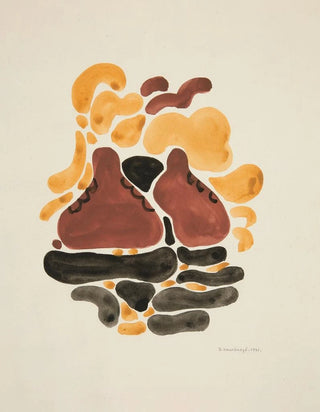Art print Abstraction based on floral shapes VI - David Kakabadze | Art print


View from behind

Frame (optional)
Art print Abstraction inspired by floral forms VI - David Kakabadze – Captivating introduction
In the fascinating universe of abstract art, the work "Abstraction inspired by floral forms VI" by David Kakabadze stands out for its boldness and delicacy. This piece, which transcends simple floral representations, invites the viewer to dive into a world where nature and abstraction blend harmoniously. Kakabadze, a Georgian artist of the early 20th century, manages to capture the very essence of blooming through dynamic shapes and vibrant colors, creating a visual experience that awakens the senses and stimulates the imagination. The art print of this work allows you to discover the richness of his artistic language while adding a touch of elegance to any interior.
Style and uniqueness of the work
Kakabadze's work is characterized by a unique approach to abstraction. In "Abstraction inspired by floral forms VI," organic shapes intertwine with fluid lines, evoking the natural movement of flowers in the breeze. The colors, both saturated and delicate, juxtapose to create a subtle balance between strength and lightness. This chromatic play, combined with stylized forms, enables the artist to transcend traditional representations of nature. The flowers, although present, are not simply reproduced; they are reinterpreted, inviting the viewer to feel their essence rather than merely observe their appearance. This innovative style makes this work an emblematic example of the capacity of art to evoke deep emotions and question our perception of the natural world.
The artist and his influence
David Kakabadze, an emblematic figure of Georgian modern art, knew how to mark his era with a forward-thinking artistic vision. Influenced by European movements of his time, notably cubism and fauvism, he developed a visual language unique to him, blending abstraction and figurative elements. Kakabadze does not merely reproduce reality; he strives to transcend it, seeking to express ideas and emotions through shapes and colors. His work has not only influenced his contemporaries but continues to inspire many

Matte finish

View from behind

Frame (optional)
Art print Abstraction inspired by floral forms VI - David Kakabadze – Captivating introduction
In the fascinating universe of abstract art, the work "Abstraction inspired by floral forms VI" by David Kakabadze stands out for its boldness and delicacy. This piece, which transcends simple floral representations, invites the viewer to dive into a world where nature and abstraction blend harmoniously. Kakabadze, a Georgian artist of the early 20th century, manages to capture the very essence of blooming through dynamic shapes and vibrant colors, creating a visual experience that awakens the senses and stimulates the imagination. The art print of this work allows you to discover the richness of his artistic language while adding a touch of elegance to any interior.
Style and uniqueness of the work
Kakabadze's work is characterized by a unique approach to abstraction. In "Abstraction inspired by floral forms VI," organic shapes intertwine with fluid lines, evoking the natural movement of flowers in the breeze. The colors, both saturated and delicate, juxtapose to create a subtle balance between strength and lightness. This chromatic play, combined with stylized forms, enables the artist to transcend traditional representations of nature. The flowers, although present, are not simply reproduced; they are reinterpreted, inviting the viewer to feel their essence rather than merely observe their appearance. This innovative style makes this work an emblematic example of the capacity of art to evoke deep emotions and question our perception of the natural world.
The artist and his influence
David Kakabadze, an emblematic figure of Georgian modern art, knew how to mark his era with a forward-thinking artistic vision. Influenced by European movements of his time, notably cubism and fauvism, he developed a visual language unique to him, blending abstraction and figurative elements. Kakabadze does not merely reproduce reality; he strives to transcend it, seeking to express ideas and emotions through shapes and colors. His work has not only influenced his contemporaries but continues to inspire many
12,34 €






